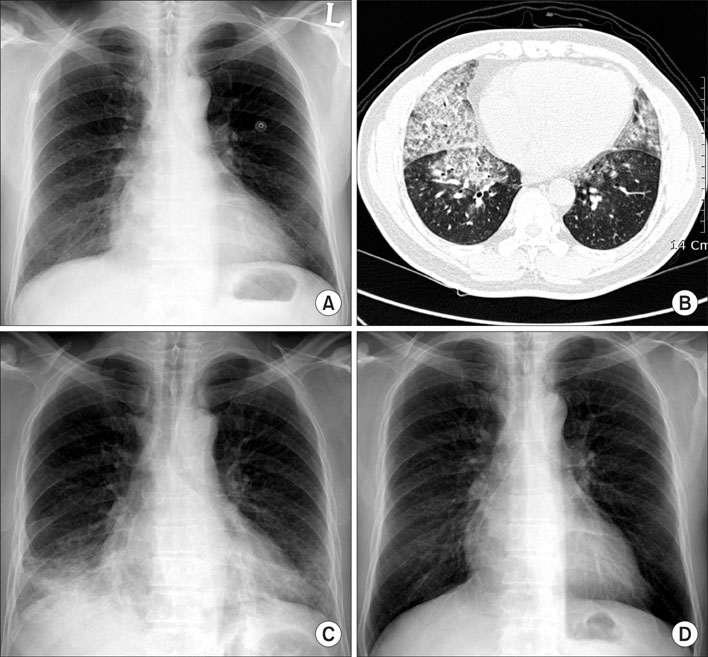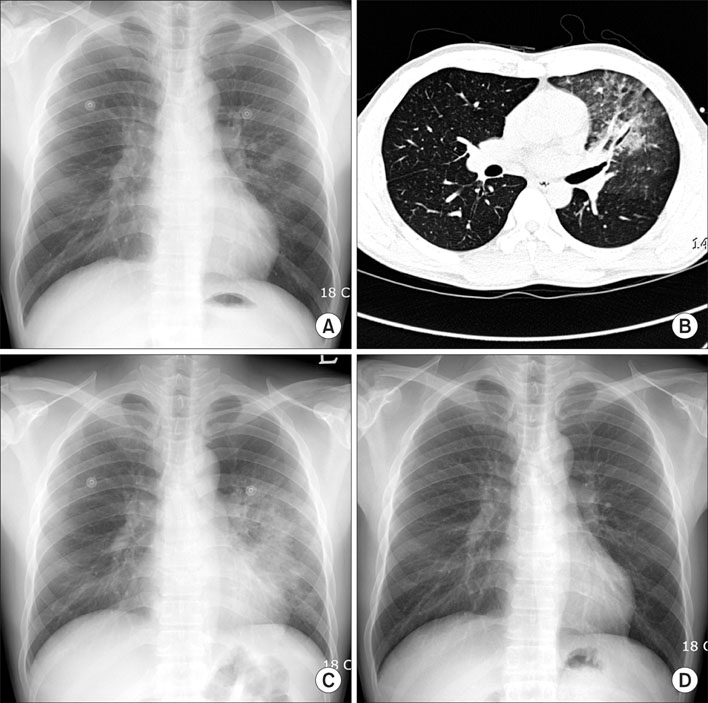Tuberc Respir Dis.
2008 Mar;64(3):210-214. 10.4046/trd.2008.64.3.210.
Two Cases of Chemical Pneumonitis Caused by Hydrogen Sulfide
- Affiliations
-
- 1Division of Respiratory and Critical Care Medicine, Department of Internal Medicine, Korea University Ansan Hospital, Ansan, Korea. chepraxis@korea.ac.kr
- 2Division of Respiratory and Critical Care Medicine, Department of Internal Medicine, Korea University Guro Hospital, Seoul, Korea.
- 3Division of Respiratory and Critical Care Medicine, Department of Internal Medicine, Korea University Anam Hospital, Seoul, Korea.
- KMID: 1478183
- DOI: http://doi.org/10.4046/trd.2008.64.3.210
Abstract
- Chemical pneumonitis is an occupational lung disease that's caused by the inhalation of chemical substances. Its severity depends on the characteristics of the substances, the exposure time and the susceptibility of the patients. Hydrogen sulfide is not only emitted naturally, but it also frequently found in industrial settings where it is either used as a reactant or it is a by-product of manufacturing or industrial processes. Inhalation of hydrogen sulfide causes various respiratory reactions from cough to acute respiratory failure, depending on the severity. Two pharmaceutical factory workers were admitted after being rescued from a waste water disposal site that contained hydrogen sulfide. In spite that they recovered their consciousness, they had excessive cough and mild dyspnea. The simple chest radiographs and high resolution computed tomography showed diffuse interstitial infiltrates, and hypoxemia was present. They were diagnosed as suffering from chemical pneumonitis caused by hydrogen sulfide. After conservative management that included oxygen therapy, their symptoms, hypoxemia and radiographic abnormalities were improved.
MeSH Terms
Figure
Reference
-
1. Kim KI, Kim CW, Lee MK, Lee KS, Park CK, Choi SJ, et al. Imaging of occupational lung disease. Radiographics. 2001. 21:1371–1391.2. Kim JS, Lynch DA. Imaging of nonmalignant occupational lung disease. J Thorac Imaging. 2002. 17:238–260.3. Jappinen P, Vilkka V, Marttila O, Haahtela T. Exposure to hydrogen sulphide and respiratory function. Br J Ind Med. 1990. 47:824–828.4. Wittram C, Kenny JB. The admission chest radiograph after acute inhalation injury and burns. Br J Radiol. 1994. 67:751–754.5. Ha JW, Lee SS, Eom KS, Bahn JW, Jang SH, Kim DG, et al. A case of chemical pneumonitis caused by nitric acid fume inhalation. Tuberc Respir Dis. 2004. 56:670–676.6. Sheridan R. Specific therapies for inhalation injury. Crit Care Med. 2002. 30:718–719.7. Jung KH, Hur GY, Jeong HC, Lee SY, Lee SY, Kim JH, et al. A case of chemical pneumonitis after occupational nitric acid inhalation. Korean J Med. 2006. 71:562–566.
- Full Text Links
- Actions
-
Cited
- CITED
-
- Close
- Share
- Similar articles
-
- Isolation of hydrogen sulfide producing escherichia coli
- Two Cases of Comatose Patients Presenting after Exposure to Hydrogen Sulfide Gas
- Serial MRI of Hypoxic Brain Damage after Hydrogen Sulfide Exposure
- Death due to hydrogen sulfide poisoning after drain cleansing in an apartment house
- Hazards Exposed to Firefighters in Fire: Physical, Chemical, and Biologic factors



